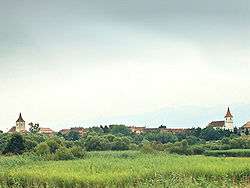Avrig
| Avrig | ||
|---|---|---|
| Town | ||
 | ||
| ||
 Location of Avrig | ||
 Avrig Location of Avrig | ||
| Coordinates: 45°42′29″N 24°22′29″E / 45.70806°N 24.37472°ECoordinates: 45°42′29″N 24°22′29″E / 45.70806°N 24.37472°E | ||
| Country |
| |
| County | Sibiu County | |
| Status | Town | |
| Government | ||
| • Mayor | David Adrian-Dumitru (PNL) | |
| Area | ||
| • Total | 133.36 km2 (51.49 sq mi) | |
| Population (2011) | ||
| • Total | 12,095 | |
| Time zone | UTC+2 (EET) | |
| • Summer (DST) | UTC+3 (EEST) | |
| Climate | Dfb | |
| Website | http://primaria-avrig.ro | |
Avrig (Romanian pronunciation: [aˈvriɡ]; German: Freck, Hungarian: Felek) is a town in the Sibiu County, Romania. It has a population of 12,815 and the first documents attesting its existence date to 1346.
Demographics
| Historical population | ||
|---|---|---|
| Year | Pop. | ±% |
| 1992 | 14,965 | — |
| 2002 | 14,260 | −4.7% |
| 2011 | 12,815 | −10.1% |
| Source: Census data | ||
At the 2011 census, 95.6% of inhabitants were Romanians, 2.1% Hungarians, 1.5% Roma and 0.5% Germans.
Geography
The town administers four villages: Bradu (Gierelsau; Fenyőfalva), Glâmboaca (Hühnerbach; Glimboka), Mârșa and Săcădate (Sekadaten; Oltszakadát). It is situated in the historical region of Transylvania.
It lies on the left bank of the river Olt (at the mouth of the Avrig River), close to the Făgăraș Mountains, at about 26 km (16 mi) from Sibiu on the road towards Brașov. It is the main starting point for the trekking routes in the western part of the mountains, and also on access point at a great number of chalets in the mountains: Cabana Poiana Neamțului, Cabana Bârcaciu, Cabana Ghiocelul.
Economy
Avrig SA Glass Factory, a company specialized in lime mouthblown glass, started its origins in Avrig in the 17th century. [1]
Mârșa village is the site of the Mecanica Mârșa Works, which manufactures auto-trailers and military vehicles. [2]
Tourism
The most important objective in the town is the Brukenthal Summer Palace built in 1771, a baroque summer residence of baron Samuel von Brukenthal, the governor of Transylvania. Also two old churches can be found there: the evangelical church, built in the 13th century and fortified in the 16th century and the orthodox church, built in the 18th century.
Bradu village features a fortified church first attested in 1315, with the last major modification in 1804.
Natives
- Gheorghe Lazăr, founder of the first Romanian-language school
- Vasile Stoica, diplomat
Image gallery
 Avrig in the Grand Duchy of Transylvania, 1769-1773
Avrig in the Grand Duchy of Transylvania, 1769-1773 Avrig in Sibiu County
Avrig in Sibiu County Fortified church of Bradu village
Fortified church of Bradu village_25.jpg)
 Brukenthal Summer Palace
Brukenthal Summer Palace
References
External links
| Wikimedia Commons has media related to Avrig. |
- Avrig Town Hall Official Site (in Romanian)
- Brukenthal Palace Avrig

